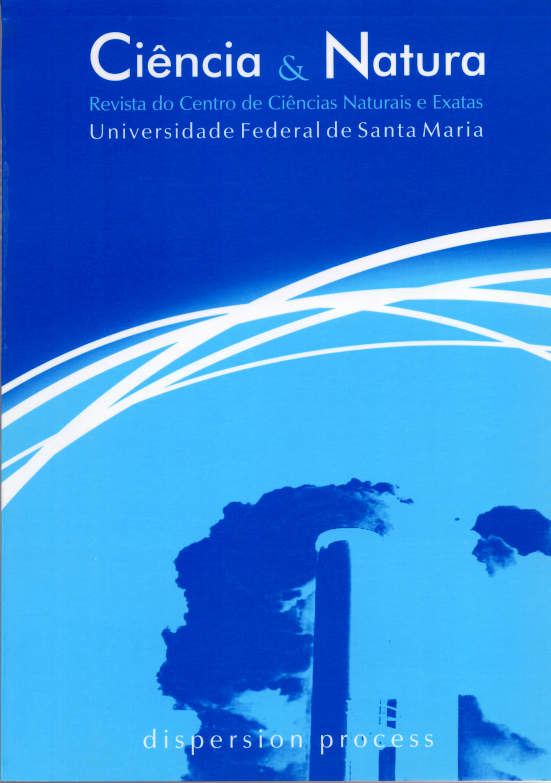Simulação numérica do transporte de um poluente inerte e passivo na CLP convectiva através de um modelo LES
DOI:
https://doi.org/10.5902/2179460X63623Keywords:
LES, Convective PBL, dispersion of inert pollutants. PBL numerical modelsAbstract
This work describes the time evolution of three dimensional structure of an inert and passive atmospheric pollutant, continuously emitted by an area source located at surface. These and other dynamic and thermodynamic properties of PBL are simulated numerically by the large eddy simulation model (LES) proposed by Moeng. The vertical structure of mean pollutant concentration and the associated vertical turbulent fluxes are consistent with a Mixed Layer, with approximately zero vertical gradients and vertical fluxes varying linearly with height. The vertical distribution of pollutant concentration variance does not follow the Mixed Layer Similarity Theory. The instantaneous vertical wind field shows an asymmetric spatial distribution, with skewness varying from 0.4, near the surface, to 1.62 at the PBL top. This result indicates that the updrafts are more intense and localized than the downdrafts. The spatial distribution of pollutant is consistent with the wind field pattern associated with the large eddies, mainly near to the top.Downloads
References
Cai, X.-M. 2000. Dispersion of a passive plume in an idealized urban convective boundary layer: A large-eddy simulation. Atmospheric Environment, 34: 61-72. DOI: https://doi.org/10.1016/S1352-2310(99)00299-X
Deardorff, J. W. 1972. Numerical investigation of neutral and unstable planetary boundary layers. Journal of the Atmospheric Sciences, 29: 91-115. DOI: https://doi.org/10.1175/1520-0469(1972)029<0091:NIONAU>2.0.CO;2
Deardorff, J. W. 1974. Three-dimensional numerical study of turbulence in an entraining mixed layer. Boundary Layer Meteorology, 7: 199-226. DOI: https://doi.org/10.1007/BF00227913
Van Haren, L. and Nieuwstadt, F. T. M. 1989. The behavior of passive and buoyant plumes in a convective boundary layer, as simulated with a large-eddy model. Journal Applied Meteorology, 28: 818-832. DOI: https://doi.org/10.1175/1520-0450(1989)028<0818:TBOPAB>2.0.CO;2
Hunt, J. C. R., Kaimal, J. C. and Gaynor, J. E., 1988: Eddy structure in the convective boundary layer – new measurements and new concepts. Quart. J. R. Meteorological Society, 114, 827-858. DOI: https://doi.org/10.1256/smsqj.48201
Lamb, R. G. 1984. Diffusion in the convective boundary layer. In: Nieuwstadt, F. T. M.; van Dop, H. Ed. Atmospheric Turbulence and Air Pollution Modelling. 1.ed. Reidel:Dordrecht, 159-229. DOI: https://doi.org/10.1007/978-94-010-9112-1_5
Marques Filho, E. P., Oliveira, A P., Karam, H. A and Rizza, U, 2002. An investigation of pollutant dispersion in a highly convective boundary layer using large eddy simulation. Submited the Meteorology and Atmospheric Physics.
Moeng, C.-H. 1984. A large-eddy simulation model for the study of planetary boundary-layer turbulence. Journal of the Atmospheric Sciences, 41: 2052-2062. DOI: https://doi.org/10.1175/1520-0469(1984)041<2052:ALESMF>2.0.CO;2
Moeng, C.-H. and Wyngaard, J. C. 1984. Statistics of conservative scalars in the convective boundary layer. Journal of the Atmospheric Sciences, 41: 3161-3169. DOI: https://doi.org/10.1175/1520-0469(1984)041<3161:SOCSIT>2.0.CO;2
Schmidt, H. and Schumann, U. 1989. Coherent structure of the convective boundary layer derived from large-eddy simulations. Journal Fluid Mechanics, 200: 511-562. DOI: https://doi.org/10.1017/S0022112089000753
Sorbjan, Z. 1999. Similarity of scalar fields in the convective boundary layer. Journal of the Atmospheric Sciences, 56: 2212-2221. DOI: https://doi.org/10.1175/1520-0469(1999)056<2212:SOSFIT>2.0.CO;2
Willis, G. E. and Deardorff, J. W. 1978. A laboratory study of dispersion from an elevated source in a convective mixed layer. Atmospheric Environment, 12: 1305-1313. DOI: https://doi.org/10.1016/0004-6981(78)90069-0
Wyngaard, J. C. and Brost, R. A. 1984. Top-down and bottom-up diffusion of a scalar in the convective boundary layer. Journal of the Atmospheric Sciences, 41: 102-112. DOI: https://doi.org/10.1175/1520-0469(1984)041<0102:TDABUD>2.0.CO;2
Downloads
Published
How to Cite
Issue
Section
License
To access the DECLARATION AND TRANSFER OF COPYRIGHT AUTHOR’S DECLARATION AND COPYRIGHT LICENSE click here.
Ethical Guidelines for Journal Publication
The Ciência e Natura journal is committed to ensuring ethics in publication and quality of articles.
Conformance to standards of ethical behavior is therefore expected of all parties involved: Authors, Editors, Reviewers, and the Publisher.
In particular,
Authors: Authors should present an objective discussion of the significance of research work as well as sufficient detail and references to permit others to replicate the experiments. Fraudulent or knowingly inaccurate statements constitute unethical behavior and are unacceptable. Review Articles should also be objective, comprehensive, and accurate accounts of the state of the art. The Authors should ensure that their work is entirely original works, and if the work and/or words of others have been used, this has been appropriately acknowledged. Plagiarism in all its forms constitutes unethical publishing behavior and is unacceptable. Submitting the same manuscript to more than one journal concurrently constitutes unethical publishing behavior and is unacceptable. Authors should not submit articles describing essentially the same research to more than one journal. The corresponding Author should ensure that there is a full consensus of all Co-authors in approving the final version of the paper and its submission for publication.
Editors: Editors should evaluate manuscripts exclusively on the basis of their academic merit. An Editor must not use unpublished information in the editor's own research without the express written consent of the Author. Editors should take reasonable responsive measures when ethical complaints have been presented concerning a submitted manuscript or published paper.
Reviewers: Any manuscripts received for review must be treated as confidential documents. Privileged information or ideas obtained through peer review must be kept confidential and not used for personal advantage. Reviewers should be conducted objectively, and observations should be formulated clearly with supporting arguments, so that Authors can use them for improving the paper. Any selected Reviewer who feels unqualified to review the research reported in a manuscript or knows that its prompt review will be impossible should notify the Editor and excuse himself from the review process. Reviewers should not consider manuscripts in which they have conflicts of interest resulting from competitive, collaborative, or other relationships or connections with any of the authors, companies, or institutions connected to the papers.







